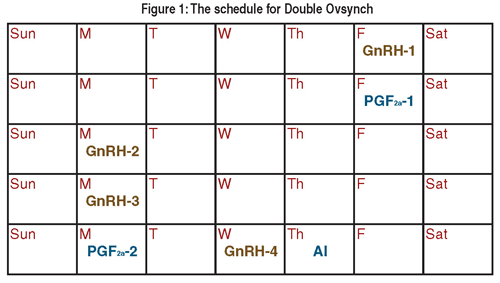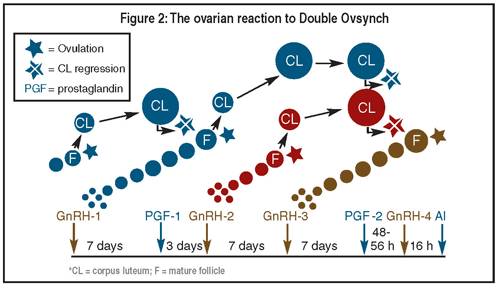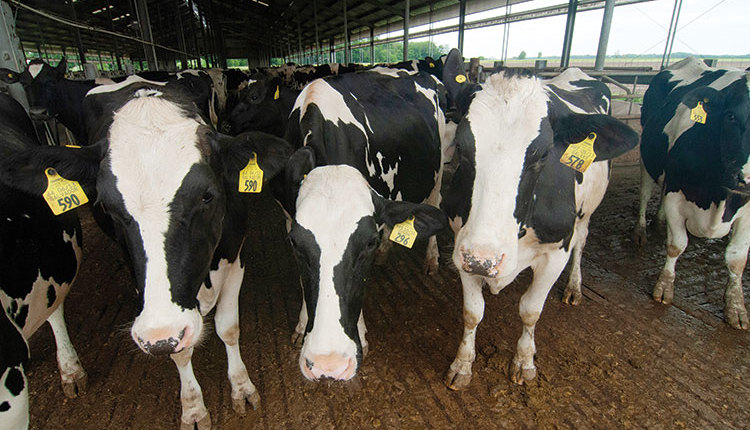The author is professor of animal sciences at Kansas State University, Manhattan.
Last month I shared with you an alternative Presynch program, G-6-G (October 10, page 620). It was suggested as an alternative to the standard Presynch protocol described in that article. A new permutation of G-6-G is what is now called Double Ovsynch. It was developed by Milo Wiltbank's group at the University of Wisconsin. This program essentially uses an Ovsynch-like protocol up front before the breeding Ovsynch TAI (timed artificial insemination) program. Its purpose is to better presynchronize follicular waves before the corpus luteum (CL) is regressed for a timed A.I. breeding. Let's look at this newer protocol and discover how it works.

Double ovsynch . . .
A weekly schedule showing how Double Ovsynch looks on a calendar is illustrated in Figure 1. In the illustration, the first Ovsynch begins on a Friday, 17 days before the breeding Ovsynch is initiated on a Monday.

The first Ovsynch is initiated with GnRH-1 followed in seven days by prostaglandin (PGF-1) and then three days later, a second GnRH injection (GnRH-2) is given to ensure ovulation occurs after prostaglandin. These GnRH injections (GnRH-1 and GnRH-2) may be quite important for cows that are not cycling because either GnRH injection could cause the cow to ovulate for the first time since calving.

Could enhance fertility . . .
Figure 2 illustrates what happens to the ovarian structures in this protocol. Ovulation after GnRH-1 results in formation of a CL and initiates a new follicular wave. This is similar to what may occur after the first injection of a single Ovsynch protocol. Because ovulation occurs before A.I., it provides some advantages for fertility. Please read on to learn how.
When PGF-1 is administered, the CL regresses and ovulation follows, either spontaneously or in response to GnRH-2. With that accomplished, a new follicular wave is initiated after GnRH-2. Seven days later, in response to GnRH-3, ovulation occurs again, with the likelihood of the cow now having two CLs, one resulting from GnRH-2 and now one that forms after GnRH-3.
This latter follicular wave produces the follicle containing the egg that should be fertilized after the timed A.I. So seven days after GnRH-3 which is the traditional first GnRH injection of the breeding Ovsynch program, the two CLs are regressed by PGF-2. In 48 to 56 hours, GnRH-4 is administered to induce ovulation. Timed A.I. should be administered about 16 hours after GnRH-4.
Shorter protocol . . .
This protocol is eight days shorter than the traditional Presynch-Ovsynch protocol. It should result in more cows ovulating in response to GnRH-3 and the future egg to be fertilized after timed A.I. to develop within its follicle in a higher progesterone environment. Both of these factors have been found to increase fertility when breeding cows with timed A.I.
The authors claim that about 40 to 45 percent of cows will be in standing heat at the time of A.I., another potential advantage to fertility. Another advantage of this protocol may be its ability to initiate first ovulation in anovulatory cows in response to either GnRH-1 or GnRH-2 before the breeding Ovsynch protocol is begun. One drawback, depending on your hormonal costs, is that the input costs may be greater for Double Ovsynch than for the Presynch-Ovsynch protocol.
The pregnancy outcomes from just one published study with limited cows shows better fertility in younger cows, but no differences in the fertility of older cows compared with a standard Presynch-Ovsynch program. More research is being conducted in other herds to verify the results from this study.
Remember that compliance to a protocol schedule is clearly the most important issue for making any protocol successful. You may have an alternative choice to Presynch-Ovsynch.
Click here to return to the Reproduction E-Sources
0911_728
Last month I shared with you an alternative Presynch program, G-6-G (October 10, page 620). It was suggested as an alternative to the standard Presynch protocol described in that article. A new permutation of G-6-G is what is now called Double Ovsynch. It was developed by Milo Wiltbank's group at the University of Wisconsin. This program essentially uses an Ovsynch-like protocol up front before the breeding Ovsynch TAI (timed artificial insemination) program. Its purpose is to better presynchronize follicular waves before the corpus luteum (CL) is regressed for a timed A.I. breeding. Let's look at this newer protocol and discover how it works.

Double ovsynch . . .
A weekly schedule showing how Double Ovsynch looks on a calendar is illustrated in Figure 1. In the illustration, the first Ovsynch begins on a Friday, 17 days before the breeding Ovsynch is initiated on a Monday.

The first Ovsynch is initiated with GnRH-1 followed in seven days by prostaglandin (PGF-1) and then three days later, a second GnRH injection (GnRH-2) is given to ensure ovulation occurs after prostaglandin. These GnRH injections (GnRH-1 and GnRH-2) may be quite important for cows that are not cycling because either GnRH injection could cause the cow to ovulate for the first time since calving.

Could enhance fertility . . .
Figure 2 illustrates what happens to the ovarian structures in this protocol. Ovulation after GnRH-1 results in formation of a CL and initiates a new follicular wave. This is similar to what may occur after the first injection of a single Ovsynch protocol. Because ovulation occurs before A.I., it provides some advantages for fertility. Please read on to learn how.
When PGF-1 is administered, the CL regresses and ovulation follows, either spontaneously or in response to GnRH-2. With that accomplished, a new follicular wave is initiated after GnRH-2. Seven days later, in response to GnRH-3, ovulation occurs again, with the likelihood of the cow now having two CLs, one resulting from GnRH-2 and now one that forms after GnRH-3.
This latter follicular wave produces the follicle containing the egg that should be fertilized after the timed A.I. So seven days after GnRH-3 which is the traditional first GnRH injection of the breeding Ovsynch program, the two CLs are regressed by PGF-2. In 48 to 56 hours, GnRH-4 is administered to induce ovulation. Timed A.I. should be administered about 16 hours after GnRH-4.
Shorter protocol . . .
This protocol is eight days shorter than the traditional Presynch-Ovsynch protocol. It should result in more cows ovulating in response to GnRH-3 and the future egg to be fertilized after timed A.I. to develop within its follicle in a higher progesterone environment. Both of these factors have been found to increase fertility when breeding cows with timed A.I.
The authors claim that about 40 to 45 percent of cows will be in standing heat at the time of A.I., another potential advantage to fertility. Another advantage of this protocol may be its ability to initiate first ovulation in anovulatory cows in response to either GnRH-1 or GnRH-2 before the breeding Ovsynch protocol is begun. One drawback, depending on your hormonal costs, is that the input costs may be greater for Double Ovsynch than for the Presynch-Ovsynch protocol.
The pregnancy outcomes from just one published study with limited cows shows better fertility in younger cows, but no differences in the fertility of older cows compared with a standard Presynch-Ovsynch program. More research is being conducted in other herds to verify the results from this study.
Remember that compliance to a protocol schedule is clearly the most important issue for making any protocol successful. You may have an alternative choice to Presynch-Ovsynch.
0911_728










